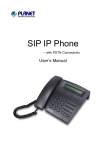Download MicroNet Technology SP5100 IP Phone User Manual
Transcript
User’s Manual Internet IP Telephone Model No.: SP5100 Website: http://www.micronet.info Version 3.0 Table of Contents 1 2 3 4 5 INTRODUCTION....................................................................................................................................... 3 1.1 PRODUCT DESCRIPTION ...................................................................................................................... 3 1.2 APPEARANCE ..................................................................................................................................... 5 1.3 SPECIFICATION OF CONNECTOR ........................................................................................................... 8 OPERATING PROCEDURE – LCD DISPLAY ......................................................................................... 9 2.1 INITIALIZE SP5100 IP PHONE.............................................................................................................. 9 2.2 LCD CONFIGURATION ....................................................................................................................... 10 WEB CONFIGURATION ........................................................................................................................ 17 3.1 NETWORK CONFIGURE...................................................................................................................... 19 3.2 H323 CONFIGURE ............................................................................................................................ 21 3.3 SYSTEM CONFIGURE ........................................................................................................................ 23 3.4 PPPOE CONFIGURE ......................................................................................................................... 24 3.5 DDNS CONFIGURE ........................................................................................................................... 25 3.6 VOICE CONFIGURE (FOR ADVANCED USER) ....................................................................................... 26 3.7 TONE CONFIGURE (FOR ADVANCED USER) ........................................................................................ 27 3.8 BUREAU CONFIGURE ........................................................................................................................ 28 3.9 SUPPORT FUNCTIONS (BOTH SIDE MUST SUPPORT) ............................................................................ 29 3.10 DSCP CONFIGURE ........................................................................................................................... 30 3.11 PHONE BOOK (FOR PEER-TO-PEER MODE ONLY) ............................................................................... 31 3.12 PASSWORD ...................................................................................................................................... 32 3.13 FIRMWARE UPGRADE ........................................................................................................................ 33 3.14 SYSTEM COMMAND........................................................................................................................... 34 3.15 VERSION INFORMATION ..................................................................................................................... 35 UPGRADE THE SP5100 IP PHONE...................................................................................................... 36 4.1 LCD PANEL CONTROL ...................................................................................................................... 36 4.2 REMOTE CONTROL: TELNET .............................................................................................................. 37 4.3 WEB MANAGEMENT .......................................................................................................................... 38 ADVANCED CONFIGURATIONS VIA TELNET .................................................................................... 39 5.1 [HELP] COMMAND .............................................................................................................................. 39 5.2 [QUIT] COMMAND............................................................................................................................... 40 5.3 [REBOOT] COMMAND ......................................................................................................................... 40 5.4 [FLASH] COMMAND ............................................................................................................................ 40 5.5 [COMMIT] COMMAND .......................................................................................................................... 41 1 5.6 [IFADDR] COMMAND ........................................................................................................................... 41 5.7 [TIME] COMMAND............................................................................................................................... 42 5.8 [PING] COMMAND .............................................................................................................................. 43 5.9 [PBOOK] COMMAND ........................................................................................................................... 43 5.10 [DDNS] COMMAND ............................................................................................................................. 44 5.11 [PPPOE] COMMAND ........................................................................................................................... 45 5.12 [SYSCONF] COMMAND ....................................................................................................................... 46 5.13 [H323] COMMAND ............................................................................................................................. 47 5.14 [VOICE] COMMAND ............................................................................................................................ 50 5.15 [TOS] COMMAND................................................................................................................................ 51 5.16 [TONE] COMMAND ............................................................................................................................. 53 5.17 [SUPPORT] COMMAND ....................................................................................................................... 54 5.18 [BUREAU] COMMAND ......................................................................................................................... 54 5.19 [ROM] COMMAND ............................................................................................................................... 55 5.20 [PASSWD] COMMAND ......................................................................................................................... 56 5.21 [RBTONE] COMMAND ......................................................................................................................... 57 2 1 Introduction SP5100 IP Phone is a full-featured IP-based telephone system, which provides VoIP service on LAN or any IP based environment. By using IP environment for voice communication, company or individual can save lots of expenses and make data and voice network converged. SP5100 IP Phone also supports PSTN analog line connection. Therefore, it can perform as the same as traditional POTS (Plain Old Telephone Service). 1.1 Product Description Features and Specification Basic Features: ● ITU-T H.323 v3 compliance ● DTMF detection/generation ● TFTP/FTP software download ● Remote configuration/reset via Telnet ● LED indication for system status:Speaker, Hold ,Mute , Message , PSTN ● Network Interface : ● Switch Hub inside, providing 2 RJ-45 sockets for 10/100Base-T connection ● 1 RJ-11 socket for PSTN connection ● Microsoft Net Meeting v3.0 compatible ● SNTP (Simple Network Time Protocol) ● Call HOLD/TRANSFER/FORWARD/MUTE ● PSTN/IP side access switch ● 10 Direct Line Button for speed dial ● Speaker Mode ● System Configuration from keypads and displayed on LCD ● Ring Tone selection ● Password setting for security ● Function Keys : Speaker , Redial , Mute , Hold , Transfer , Forward , Message , PSTN ● Ten sets last Phone Number redial ● Dial plan ● Provide ToS (Type Of Service) function ● Gatekeeper mode or Peer to Peer mode selection 3 Caller ID: ● IP side display H323-ID and E.164. ● Display the count of total call received. ● Display un-answered call name, number. ● Show caller’s name, number, calling time. Volume Adjustment: ● Speaker volume level adjustable. ● Handset Receiver volume level adjustable. LCD: ● ● ● ● lines, 24 character Dot Matrix display. Indicator messages of HOLD, MUTE, PSTN, Directed Line 1~10. Display current date and time. Display of call duration. Audio features: ● Codec -- G.711 a/µlaw, G.723.1 (6.3Kbps),G.729, G.729a ● VAD (Voice Activity Detection), CNG (Comfort Noise Generate) ● G.168/165-compliant adaptive echo cancellation ● Dynamic Jitter Buffer ● Bad Frame Interpolation ● Provide H.245 Out-band DTMF message ● Call Transfer (H.450.2) ● Call Forward (H.450.3) ● Call Hold (H.450.4) ● Gain (Voice Volume) Settings ● Provide Call Progress Tone: Dial tone, busy tone, call-holding tone and ring-back tone Firmware Upgrade: ● Firmware version displayed on LCD. ● Two ways to upgrade firmware: - Download by KEYPAD configuration. - Download by Telnet. Management Features: ● SP5100 IP Phone KEYPAD ● TELNET ● Web Browser 4 1.2 Appearance 1. Front View and Keypad function ● ● C: Cancel and Clear ÍÎ : Move to left /previous and right / next. ● ● OK: Press OK to confirm the modification. Direct Line (DL) Button 1 – 10: User press DL button to do speed dial according to phone book data 1-10 (please refer to LCD configuration-Phone Address Book or Advanced Configurations via Telnet-[pbook] command ). ● Number 1 –10, * and #: The function is as the same as the general phone set. Corresponding list of keypad and symbol: 1 “Space” ; “,” ; “.” ; “!” ; “1” 2 “A” ; “ B” ; “C” ; “2” 3 “D” ; “E” ; “F” ; “3” 4 “G” ; “H” ; “I” ; “4” 5 “J” ; “K” ; “L” ; “5” 6 “M” ; “N” ; “O” ; “6” 7 “P” ; “Q” ; “R” ; “S” ; “7” 8 “T” ; “U” ; “V” ; “8” 5 ● ● 9 “W” ; “X” ; “Y” ; “Z” ; “9” * “-“ ; “?” ; “*” 0 “0” # “_” ; “@” ; “#” MUTE: Mute the voice of MIC and let others can’t hear from user in communication. PSTN: Press PSTN to switch SP5100 IP Phone as PSTN or IP Phone Mode. In PSTN mode, “PSTN” characters will be displayed on LCD left bottom side, then users can dial out as if standard telephone set in PSTN; in IP Phone mode, “GK” characters will be displayed on LCD left bottom side. Note: 1. When IP Phone is in PSTN mode, only PSTN and SPEAKER function key can work. 2. On LCD will display”….Incoming Call…. ” to notice user when IP Phone has both IP and PSTN side incoming calls. 3. If in communication with IP side, user can press HOLD to hold IP side, then press PSTN to pick up PSTN side, after that can press HOLD again to retrieve IP side. 4. If in communication with PSTN side, user must hang up PSTN side before pick up IP side. ● ● HOLD: To hold a call with H.450 function. SPEED: Press SPEED and number (Phone book index) to do speed dial according to phone book data (please refer to LCD configuration-Phone Address Book or Advanced Configurations via Telnet-[pbook] command). ● FORWARD: Forward a incoming call to another IP device by H.450 forward function.(please refer to LCD configuration-Indicate Forward Type) ● MESSAGE and its indicated LED light: When missing the incoming calls, the message LED will be flashing. User can know the information of miss call by pressing the message button. ● TRANSFER: 1. Transfer a call by H.450 transfer function. Press TRANSFER button in communication and press phone No. which user want to transfer to can transfer this call. 2. Change characters to be capital or lowercase: when press TRANSFER before press letters can switch type of letters. ● ● ● REDIAL: Redial the last outgoing call. + and - : Adjust the voice volume in communication. SPEAKER: Speaking without picking up handset. 6 Note: All function keys mentioned above (except Number 1 –10, * and # ) are effective only in IP Phone mode. 2. Back View n o p q DC 9V: DC 9V power input outlet LAN: RJ-45 connector, connected directly to the Hub through the straight CAT-5 cable. PC: RJ-45 connector, connected directly to the PC through the straight CAT-5 cable Line: RJ-11 connector, connected directly to the PSTN analog line. Note: There are two LED indicated lights: LINK/ACT and 10/100 for LAN port and PC port. When network status is in normal, LED of LINK/ACT will be flashing; when transmit rate is in 10 mbps/100mbps, LED of 10/100 will light off/on. 7 1.3 Specification of connector 1、 Ethernet Port: Ethernet port is for connecting IP Phone to network, transmit rate supports 10/100 Base-T. Ethernet connector(LAN) 2、 RJ11connector: RJ11 connector is for connecting IP Phone with PSTN. RJ11connector 8 2 Operating Procedure – LCD Display 2.1 Initialize SP5100 IP Phone 1. When power on the SP5100 IP Phone, the LCD screen shows as below. IP-Phone Board Start Booting 2. Wait around one minute until the SP5100 IP Phone finishes boot program initialization. 3. User can see flashing greeting as below: System Initializing……… 4. Then IP Phone get into standby mode: IP-Phone GK 10:10:10 AM The main LCD screen would be shown as similar as above. The GK word means the SP5100 IP Phone is in Gatekeeper Mode, and when IP Phone is connected to SNTP server, on LCD will show current time from SNTP server. 5. After pressing the PSTN button, the GK word will be replaced by PSTN. Then IP Phone is in PSTN Mode. Please notice that in PSTN mode user must plug PSTN line in RJ-11 port. IP-Phone PSTN 10:10:10 AM Press Í or Î to enter configuration mode then press OK Bottom to enter certain menu. There are 6 selections for configuration. 1. System Configuration (mandatory, protected by password) 2. User Line Number (mandatory) 3. Ring Configuration 4. Indicate Forward Type 5. 6. Message Box Phone Address Book 9 Note: LCD Panel of SP5100 IP Phone is operated manually by moving Í or Î on the keypad. Press OK to enter separate configuration menu. Press C to go back to the main menu. 2.2 LCD Configuration User can set the following 10 configurations manually by operating the commands displayed on LCD. Note: Any configurations that have made for the SP5100 IP Phone, user has to do Reboot in the selection 1→5 “Reboot”. System Configuration (mandatory, protected by password) z Please Enter Password: User must key in password to enter this menu, selections under this command are all important ones, which can only be configured by administrators. Note: 1. Password to enter System Configuration: 2. H.323 token password (please refer to item 9), default value is x. (Please press TRANSFER button to switch as lowercase characters first.) 3. If users forget password, please contact us for the specific password generated according to MAC address of IP Phone. 1. Connect Configuration There are ten sub-configurations included in Connect Configuration. It is necessary for user to set it in order to run the SP5100 IP Phone correctly. In addition, user has to prepare one valid IP Address to meet your network environment. (Global public IP Address or Virtual IP Address) (1) IP address In this configuration mode, user presses the prepared IP Address on the IP Phone keypad. Please input IP address as format: xxx.xxx.xxx.xxx. (2) Subnet Mask: User has to press the subnet mask IP Address on the IP Phone keypad. 10 (3) Gateway User has to press the default gateway IP which meets IP Address on the IP Phone keypad. (4) Primary DNS User can set IP address of Domain Name Server, then for Gatekeeper and Phone book can enter URL address or IP address. Please refer to 5.9 [pbook] and 5.13 [h323] command. (5) Secondary DNS User can set IP address of secondary DNS, once primary DNS cannot work normally, IP Phone can refer to secondary DNS. (6) Gatekeeper User has to offer one available Gatekeeper server IP Address and set this IP Address on the IP Phone keypad. (7) Second Gatekeeper IP Phone provide alternative Gatekeeper feature, if IP Phone can’t register to Main Gatekeeper for 10 times, it will try to register to the Second Gatekeeper. When main Gatekeeper can’t work normally, IP Phone can still keep working with Second Gatekeeper (8) SNTP Configuration SP5100 IP Phone supports that user can assign one SNTP (Simple Network Time Protocol) Server in your country by setting in IP Phone. User has to offer one available SNTP server IP Address and set this IP Address on the IP Phone keypad. (A) SNTP Mode: User can set different time can set SNTP function too be on/off/broadcast, which means IP Phone will capture current time from SNTP server or not, or broadcast to find a SNTP server and capture current time. (B) SNTP Server: User can specify a SNTP server for IP Phone to capture current time. (C) Time Zone: User can set time zone according to the location IP Phone is. For example, in Taiwan the time zone should be set as 11 8,which means GMT+8.(user can press “*” as “-“) Note: If user didn’t set SNTP server, on LCD won’t display current time. (9) Connection Mode There are 2 types for SP5100 IP Phone to connect to the other devices. They are GK, P2P. The default mode is in GK mode. When user would like to connect via P2P mode, the SP5100 IP Phone must change as well. Move the “~” symbol by press Í or Î on the keypad to select one mode. (10) DHCP Mode (ON/Off) User can set IP Phone in DHCP mode, which means IP Phone will get a dynamic IP automatically. (11) Token Password (A) LCD menu password: User can enter LCD system configuration by key in this password (B) H.235 security: To set RRQ/ARQ authentication token password. If IP Phone wants to register to a Gatekeeper, which implement H.235 security token feature, IP Phone has to set a RRQ/ARQ authentication token password, which is provided by Gatekeeper manager. IP Phone can’t work normally with this Gatekeeper unless Token Password is set. (12) GRQ Option To set auto discovery function OFF or ON. If this function is enabled and IP address of Gatekeeper is set as 255.255.255.255, IP Phone will multicast to search a Gatekeeper on network with configured Gatekeeper ID (please refer to (13) Gatekeeper ID); if IP address of Gatekeeper is set, before IP Phone register to the assigned Gatekeeper, it will send out GRQ (Gatekeeper Request) message with configured Gatekeeper name to Gatekeeper first. (13) Gatekeeper ID To set Gatekeeper name for Gatekeeper discovery. When IP Phone send out Gatekeeper discovery message will search Gatekeeper with this Gatekeeper name 12 2. User Line Name User has to identify one ID name for the SP5100 IP Phone to register to the Gatekeeper. 3. Firmware Update (1) Download method There are two methods to download new rom file, please move the “~” symbol by press Í or Î on the keypad to select TFTP or FTP method, then press OK to confirm it. (2) Set File Server IP User has to offer one TFTP/FTP server IP Address and set this IP Address on the IP Phone keypad. The IP Address is necessary for upgrading IP Phone new application rom file. (3) Set FTP user account User has to press user name and password for FTP server login .It is necessary for upgrading IP Phone’s new application rom file in FTP method. (4) Indicate file name User has to press the file name of new application rom file prepared for upgrading (5) Start Download Press OK to start download new application rom file. After download is finished, IP Phone will automatically reboot. (6) Firmware Version Show versions of all rom files and hardware. Note: 1. Download via LCD command can only upgrade new application rom file. 2. If IP Phone fails to upgrade via LCD menu, IP Phone will automatically reboot. 4. Hardware Test SP5100 IP Phone provides self-test for all functions buttons. Please follow the direction from LCD panel to operate and verify it. 5. PPPoE Configuration (1) PPPoE Mode 13 Choose ON or OFF to enable or disable PPPoE function. (2) Username And Password To set PPPoE connection user name and password. (3) Retry When Disconnect Choose ON or OFF to enable or disable this function. If users enable this function, after PPPoE being disconnected, IP Phone will automatically reboot to re-connect, and after reboot, if IP Phone still can’t get contact with server, IP Phone will keep trying to connect. On the other hand, if users disable this function, IP Phone won’t reboot and keep trying to connect. 6. Reboot It is necessary and important for user to reboot it after any configurations has been made to the SP5100 IP Phone. 2. User Line Number User has to identify at least one number for the SP5100 IP Phone to register to the Gatekeeper. User can set up to 10 different numbers. (1) Line Number 1 (2) Line Number 2 (3) Line Number 3 (4) Line Number 4 (5) Line Number 5 (6) Line Number 6 (7) Line Number 7 (8) Line Number 8 (9) Line Number 9 (10) Line Number 10 Note: User can set six zero “000000” on LCD to disable this number and the number after this one. Ex. Line Number 1-5 are configured, if user set Line 3 as “000000”, Line number 3-5 will be disabled. 3. Ring Configuration (1) Ring Style Selection There are three tone styles for SP5100 IP Phone. Move the “~” symbol by pressing Í or Î on the keypad to select the tone style preferred. Then press 14 OK to confirm it. Choose Tone Style: Low Middle High (2) Ring Volume Control User can adjust ring volume by pressing Í or Î on the keypad to decrease or increase volume. 4. Indicate Forward Type There are two selections to activate or deactivate forward function. After selection please press OK i. Activate: choose under which situation to forward call to another endpoint. After selection please press OK, then enter LINE NUMBER of another endpoint prepared to forward to. A. Busy When SP5100 IP Phone is in busy status, the incoming call will be directly forwarded to the assigned phone number. B. No response When SP5100 IP Phone is continuing ringing around 10 seconds, the incoming call will be directly forwarded to the assigned phone number. C. Unconditional It is included the above two types. Whether the IP Phone is in which status, it will be automatically forwarded to the assigned phone number. ii. Deactivate: choose under which situation to deactivate forward function. After selection, please press OK, then user can see LINE NUMBER of the endpoint which is already configured to forward to, now press OK again. Note: The number that user prepares to forward to is E.164 number which is registered on the Gatekeeper. 5. Message Box If there is an unanswered IP call, it will be kept in message box . MESSAGE LED will be flashing until user press MESSAGE to check miss call and re-press MESSAGE to return to main screen. • New Call:to see all incoming-call records in message box. • History:to see all records in message box. 15 6. Phone Address Book • Display Display all name and telephone number recorded to the phone address book. • Add Add and save name, telephone number and IP address of the phone address book. • Edit Edit name, telephone number, and IP address of Phone book. • Delete Delete the record in the phone address book. Note: When key in IP address in Pbook table, please do not add 0 before IP address (ex.10.1.1.1 please do not key in 010.001.001.001). 7. PPPoE Information All items below can only be displayed when PPPoE connection is established, user can check related information here. • PPPoE Status • Note Information • PPPoE IP address • Destination Host • DNS Primary • Subnet Mask • Authentication • Protocol • Device 16 3 Web Configuration The initial version for HTTPD web management interface provides user to configure easily rather than command operating method through RS-232 / TELNET. The configuration function and step is similar with the way through command line. Basically this version is not the finalized version for web interface. Initially please refer to the manual for more information. Below provide a simple user guide for user to configure via web interface. Next version for HTTPD web management will not like the command format, but friendly interface. Step1. Browse the IP Address predefined via Keypad or TELNET Step2. Input the login name and password ● ● Login name: root / administrator Password: None (just press Enter in default value) 17 Step 3. The web interface main screen Step 4. Start configure Most of all commands displayed in console / telnet are transfer to web interface. The most important commands are Network Interface, H323 Information, Commit Data and Reboot System. The method is as the same as command mode. 18 3.1 Network Configure - DHCP: Enable / Disable to DHCP mode IP Address: Set IP Address Subnet Mask: Set the Subnet Mask Default gateway: Set Default routing gateway Domain Name Server: Set Domain Name Server IP address SNTP: Enable / Disable the Simple Network Time Protocol SNTP Server Address: Set SNTP Server Address GMT: Set time zone for SNTP Server time IP Sharing: Enable it if behind IP Sharing router IP Sharing Server Address: Set WAN IP Address of IP Sharing Server router if it is a fixed one. - IP Change Feature: enable/disable IP change Function Web Configure Server Port: set http port for configuration via web browser Please be noted: If the WAN IP Address of IP Sharing Server router is not a fixed one, it is not necessary 19 to input any values. If behind the dynamic WAN IP Address situation please configure as GK mode and select special Gatekeeper, please refer to your vendor. 20 3.2 H323 Configure - Mode: Select GK mode or Peer-to-Peer mode Gatekeeper IP Address: Set Gatekeeper IP Address 2nd Gatekeeper IP: Set Redundancy Gatekeeper IP Address Gatekeeper Id: Set Gatekeeper ID Gatekeeper Discovery: Enable/Disable GRQ function Registered E.164 Number-01: Set 1st phone number Registered E.164 Number-02: Set 2nd phone number Registered E.164 Number-03: Set 3rd phone number Registered E.164 Number-04: Set 4th phone number Registered E.164 Number-05: Set 5th phone number Registered E.164 Number-06: Set 6th phone number Registered E.164 Number-07: Set 7th phone number Registered E.164 Number-08: Set 8th phone number Registered E.164 Number-09: Set 9th phone number Registered E.164 Number-10: Set 10th phone number Registered H.323 ID: Set Registered Alias as H323 ID 21 - Token Password: Set Token password for H.235 security use RTP Port Time to Live (TTL) Gatekeeper finding port Response Timeout Connection Timeout: For Advanced User only RAS Port 22 3.3 System Configure - Keypad Type: Select different DTMF Keypad Type (For Advanced User) Dial Plan: Set DTMF digit limitation (0 is for any digits) Call Alive: Enable the function to check connection (Both side must support) Inter Digit Time: Set the DTMF inter digit time (second) Digit Type of End of Dialing: Select end of dialing type as none, OK, #, or * . H.450 Related Features: Enable/Disable H.450 function. 23 3.4 PPPoE Configure - Device: Enable/Disable PPPoE function User Name: Set PPPoE Connection User Name Password: Set PPPoE Connection password Reboot After Remote Host Disconnection: Enable/Disable auto reboot after PPPoE disconnection - Other items: After PPPoE connection established, related information will be displayed 24 3.5 DDNS Configure - Status: to enable/disable DDNS function Server: to choose one DDNS server, on which user has already registered. (Now only one DDNS server is available---www.dyndns.org) - Localhost Name: to set the registered Domain Name of IP Phone User ID: to set login ID of registered account to log in DDNS server User Password: set password of registered account to log in DDNS server Check Host Current IP Address: to enable/disable check IP function. If IP Phone is behind IP sharing, when this function is enabled, IP Phone will check its public IP address by asking IP address check server and send to DDNS server to update DDNS data. If this function is disabled, when IP Phone is behind IP sharing, it will send it’s private IP address to DDNS server - Primary Service Server: to set IP address check server Secondary Service Server: to set secondary IP address check server Check every minutes hours off: to set the update interval time. IP Phone will re-update its IP address in this time. 25 3.6 Voice Configure (For Advanced User) - Codec Priority: It got wrong order with “Frame Size”. Select the packet size in sending process. (For Advanced User) - Sending Packet Size: Select the Codec Priority. (For Advanced User) G.723 Silence Suppression: Enable / Disable (For Advanced User) Volume: Adjust the volume in “Voice” (sending out); “Input” (receiving); “ DTMF” (DTMF sending out) Please Noted the value is limited. - Echo Cancel: Enable / Disable (suggested always Enable) Jitter Buffer: Min. Delay and Max. Delay (For Advanced User) 26 3.7 Tone Configure (For Advanced User) - Busy Tone - Reorder Tone - Ring Tone 1 - Ring Tone 2 - Dial Tone Set the above tone Frequency, Level and On/Off time 27 3.8 Bureau Configure - Hold Tone Generation (using PCM file): Enable/Disable hold tone generation 28 3.9 Support Functions (Both side must support) - Fast Start: - H.245 Tunneling: - H.245 Separate Channel: Enable to do Fast Start Enable to open H.245 Tunneling Enable/Disable open H.245 channel after fast start connection 29 3.10 DSCP Configure Set Signal or RTP Packet DSCP value: - Assured Forwarding (AF) PHB: Select Delay priority and Drop Precedence Expedited Forwarding (EF) PHB: Select ToS value as EF Default: Select ToS value as 0 User Assign Special DSCP Code: User can set other unspecified value here. 30 3.11 Phone Book (For Peer-to-Peer mode only) User can specify 20 sets of phone book via web interface. Input the Name, IP Address and E.164 No. of the destination device. 31 3.12 Password First select login name as root or administrator, then enter current password , new password and confirm new password again. 32 3.13 Firmware Upgrade - TFTP Server IP Address: Set TFTP server IP address Target File name: Set file name prepared to upgrade Method: Select download method as TFTP or FTP FTP Server IP Address: Set FTP server IP address FTP Login: Set FTP login name and password Target File Type: Select which sector of IP Phone to upgrade 33 3.14 System Command Press CLEAN will clean all configurations of IP Phone and reset to factory default value. Please be noted: Once execute this function, user must re-configure all commands all over again. Press reboot will reset IP Phone. 34 3.15 Version Information Display current version list. 35 4 Upgrade the SP5100 IP Phone SP5100 IP Phone supports three methods to upgrade the new version. All methods are necessary to prepare the TFTP program on the host PC as TFTP server. After installing TFTP program on one PC and connecting to network, SP5100 IP Phone is ready to be upgraded. 4.1 LCD Panel Control 1.Choose the 1→3 selection-Firmware Upgrade. Press OK to enter into the sub-selection as below. 2. Download method There are two methods to download new rom file, please move the “~” symbol by press Í or Î on the keypad to select TFTP or FTP method, then press OK to confirm it. 3. Set File Server IP User has to offer one TFTP/FTP server IP Address and set this IP Address on the IP Phone keypad. The IP address is necessary for upgrading IP Phone new application rom file. 4. Set FTP user account User has to press user name and password for FTP server login .It is necessary for upgrading IP Phone new application rom file in FTP method. 5. Indicate file name User has to press the file name of new application rom file prepared for upgrading 6. Start Download Press OK to start download new application rom file . 7. Firmware Version Show versions of all rom files. Note: • Download via LCD command can only upgrade new application rom file. • If IP Phone fails to upgrade via LCD menu, IP Phone will automatically reboot. 36 4.2 Remote Control: Telnet • -print: show versions of all rom files. • -app,-boot, -dsptest, -dspcore, -dspapp, -rbpcm and -htpcm: upgrade main boot code, main application code, DSP testing code, DSP kernel code, DSP application code, Ring Back Tone PCM file and Hold Tone . • -s: it is necessary to prepare TFTP/FTP server IP address for upgrading rom file. • -f: the file name prepared for upgrading is necessary as well. • -server: specify TFTP/FTP server IP address. It is corresponding to LCD configuration -firmware upgrade-Set file Server IP. • -method: specify download method to be TFTP or FTP(0 for TFTP.1 for FTP) • -ftp: specify user name and password for FTP download method For example: User prepares to upgrade the latest app rom file – lp.505, the TFTP server is 192.168.1.1. rom -app -s 192.168.1.1 -f lp.505 (If -server is specified , can just type rom -app -f lp.505) 37 4.3 Web Management - TFTP Server IP Address: Set TFTP server IP address Target File name: Set file name prepared to upgrade Method: Select download method as TFTP or FTP FTP Server IP Address: Set FTP server IP address FTP Login: Set FTP login name and password Target File Type: Select which sector of IP Phone to upgrade 38 5 Advanced Configurations via Telnet After initializing the SP5100 IP Phone IP Address setting (please refer to LCD Configuration: 1.Connect Configuration), user can enter into configuration mode via telnet. Note: ● After user enter IP Phone configuration via telnet, please use login : ”root”, password : ”press enter” to enter command line. ● Each command user must key-in with lower case, but contents of configurations such as h.323 alias or user name etc, user can set as capital case. ● User who changes any configuration needs to do the commit command then reboot command. 5.1 [help] command Type help, man or ? to display all the command lists. The following figure is shown all commands of SP5100 IP Phone. 39 5.2 [quit] command Type quit / exit / close will logout SP5100 IP Phone and Telnet Program. 5.3 [reboot] command After typing commit command, type reboot to restart the SP5100 IP Phone. Sometimes after user type reboot, on terminal screen will display: "Data modified, commit to flash rom?" which means IP Phone will record call history or not.(ex. REDIAL , outgoing and incoming call data) 5.4 [flash] command This command will clean the configuration stored in the flash rom to default value and reboot the SP5100 IP Phone. Note: After user upgrade new software version, suggested to execute this command to make sure new software work well on SP5100 IP Phone. Note: To execute the command flash -clean, all configuration of SP5100 IP Phone stored on flash rom will be cleaned. It is authorized for the user whose login name is “root” only. 40 5.5 [commit] command Save any changes after configuring the SP5100 IP Phone. 5.6 [ifaddr] command Configure and display the SP5100 IP Phone IP information. • -ip, -mask, -gate: Set SP5100 IP Phone IP Address, subnet mask and default gateway respectively. • -dhcp: When DHCP function enables (ifaddr -dhcp 1), SP5100 IP Phone will automatically search DHCP server after execute the commit and reboot command. Note: After IP Phone catch a dynamic IP address form DHCP server, user can see this IP address on LCD connect configuration. • • • • • -sntp: When sntp server is available, enable SP5100 IP Phone SNTP function and point to sntp server IP address. (ifaddr -sntp 1 “xxx.xxx.xxx.xxx”) -dns:User can set Domain Name Server IP address. Once IP Phone can connect with DNS server, user can specify URL address instead of IP address for Gatekeeper and phone book IP address. (Please refer to [h323] command and [pbook] command) -timezone: User can set different time zone according to the location IP Phone is. For example, in Taiwan the time zone should be set as 8, which means GMT+8. (GMT-8: ifaddr -timezone -8) -ipsharing: If SP5100 IP Phone is behind a IP-sharing , user can enable IP sharing function and specify public IP address.(ifaddr -ipsharing 0 / 1 “public IP address of IP sharing” , 0 for disable and 1 for enable) 41 • -ipchange: If user uses NAT device which support multiple public IP address, and IP Phone enable IP change function, IP Phone will register to Gatekeeper with the public IP that IP Phone uses but not the IP NAT uses. • -http: set http port. User can configure IP Phone via web browser, default http port is 80, if port 80 is not available or user has more than 1 IP Phone behind NAT, http port can be changed to another available port. 5.7 [time] command When sntp server is established as well as the sntp function of SP5100 IP Phone is enabled, type time command should show the current time what is retrieved from the assigned sntp server. Note: Please refer to the [ifaddr] command to configure sntp server. 42 5.8 [ping] command Command ping can test which the IP address is reachable or not. Usage: ping “xxx.xxx.xxx.xxx(IP address)” The message will display packets transmitting condition or no answer from the IP address. 5.9 [pbook] command The command is for Peer-to-Peer Mode use only. Therefore, VoIP products such as SP5100 IP Phone that support Peer-to-Peer Mode are also available to be addressed on the SP5100 IP Phone phone book. • -print: display phone book data. User can print all data in phone book by command (pbook –print). Furthermore, user can also print only a section of data by indicating parameter 'start_record' and 'end_record' (pbook –print “start prefix” “end prefix”). If parameter 'end_record' is omitted, only record 'start_record' will be display (pbook –print “start prefix”). • -add: add a new record in phone book table by give a name and e164 number for the Gateway / Terminal IP address . (pbook –add name “X” ip “xxx.xxx.xxx.xxx” e164 “X”) User can set IP or URL address (Domain Name Server must be configured. Please refer to [ifaddr] command) • -search: search any record such as ip address, name and e164 addressed on the phone book. • -delete: delete a record with index listed in phone book table. (pbook –delete “index 43 number”) • -insert: insert an record in specified index of phone book. • -modify: modify any record that has addressed to index number. The name, IP address and e164 number should be modified together in one modify command. (pbook –modify “index” name “X” ip “xxx.xxx.xxx.xxx” e164 “X”) Note: Please dial “#” after dial e.164 of pbook. 5.10 [ddns] command This function is for Dynamic Domain Name Server service. Once users register to one DDNS server, he can specify domain name for the IP Phone. When IP Phone reboot, it will automatically update its IP address to DDNS server. In this way, even IP Phone is using dynamic IP address, other endpoint can locate this IP Phone by its domain name. • -print: display DDNS overall information and configuration. • -enable: to enable/disable DDNS function. (ddns –enable 0 / 1, 0 for disable and 1 for enable). • -server: to set IP address of DDNS login server. • -hostname: to set the registered Domain Name of IP Phone. (ex. 44 ddns –lp001.ddns.org) • -id: to set login ID of registered account to log in DDNS server. • -passwd: to set password of registered account to log in DDNS server. • -checkip: to enable/disable check IP function. If IP Phone is behind IP sharing, when this function is enabled, IP Phone will check its public IP address by asking IP address check server and send to DDNS server to update DDNS data. If this function is disabled, when IP Phone is behind IP sharing, it will send its private IP address to DDNS server. • -checkipsrv: to set IP address of IP address check server. • -delay: to set the update interval time. IP Phone will re-update its IP address in this time. (ddns –delay 1-59m/1-24h , m means minute, h means hour) • -force: to force to execute DDNS update. Once users enter this command, IP Phone will update DDNS data immediately. (ddns –force “IP address of IP Phone”) Note: 1. For now we only support DDNS server as www.dyndns.org and www.3322.org. 2. User must register to DDNS server first, and specify user name and password in ddns -id and ddns –passwd. 3. The default IP address of DDNS login server is member.dyndns.org and members.3322.org. 4. User has to specify domain name applied for IP Phone in ddns –hostname. 5. The default IP address of check IP server in is checkip.dyndns.org. 5.11 [pppoe] command • -print: display system overall information and configuration. IF IP Phone has already connected to PPPoE server, user can see IP address and related information with this command. • -dev: to enable or disable PPPoE function. (pppoe –dev 0 / 1) • -open: to open PPPoE connection (If IP Phone is not in PPPoE connection, user can try to connect with pppoe -open) • -close: to close PPPoE connection (If IP Phone is in PPPoE connection, user can disconnect with pppoe -close) • -id: to set PPPoE connection user name • -pwd: to set PPPoE connection password • -reboot: If user enable this function, after PPPoE being disconnected, IP Phone will automatically reboot to re-connect, and after reboot, if IP Phone still can’t get 45 contact with server, IP Phone will keep trying to connect. After re-connected, IP Phone will also restart system. On the other hand, if users disable this function, IP Phone won’t reboot and keep trying to connect. (pppoe –reboot 0 / 1) Note: Firmware of IP Phone is separated into normal version and PPPoE version. In Normal version has no ToS command. 5.12 [sysconf] command This command displays the system information and configuration. • -print: display system overall information and configuration. • -plan: It is for setting dial numbering plan. While e164 number is three digits, the plan should be set as 3 or 0. The plan 0 is for any positive digits use. Note: Before change to Peer-to-Peer mode from GK mode, please remember to set dial plan as 0, or it may works not normally in P2P mode. • -keypad: set DTMF type .User can select DTMF type IP Phone receive and transmit.(sysconf –keypad 0 / 1 / 2 / 3 , 0 for inband ,1 for H.245 alphanumeric, 2 for H.245 signal type, 3 for Q.931 user info, 4 for RFC2833.) • -idto: set the duration (in second) of two pressed digits in dial mode as timed out. If after the duration user hasn’t pressed next number, IP Phone will dial out all number pressed. • -eod: select end of dialing key, e.g set end of dial key as OK button , after finished pressing dialing number then press OK will dial out. (sysconf –eod 0/1/2/3 , 0 for no end of dial key , 1 for “OK” button , 2 for “#” button , 3 for “*” button ) • -h450: Enable or disable H.450 related features, which include transfer, hold and forward. 46 5.13 [h323] command • -print: display H.323 stack information and configuration. • -mode: configure SP5100 IP Phone as Gatekeeper or Peer-to-Peer Mode. Usage: h323 –mode 0 / 1(0 for Gatekeeper mode,1 for Peer-to-Peer mode) • -gk: set Main Gatekeeper IP address (h323 –gk “xxx.xxx.xxx.xxx”) or URL address (Domain Name Server must be configured. Please refer to [ifaddr] command) . User can set IP as 255.255.255.255 and let IP Phone auto discovery for Gatekeeper. Please notice in this case, user must enable Gatekeeper discovery function. Please refer to 5.-gkname and 10.-gkdis. • -dfgw:to set IP address of default gateway, this function is the same as Microsoft NetMeeting. 1. To implement this feature both calling and called endpoints must be under peer-to-peer mode. 2. If the called party is FXO products, such as Micronet SP5050, which Have to set sysconf –2nddial 0 to make one-stage dialing. I. Dial remote PSTN number under default gateway, IP Phone will automatically dial to default gateway, then default gateway will dial this number to PSTN side. II. For example, user wants to dial to ext.888 under Micronet SP5050, user only have to dial 888 from IP Phone. 3. If called party is FXS products such as Micronet SP5004: user can dial line number of Micronet SP5004 from IP Phone. For example ,user wants to dial to Micronet SP5004, the configuration of 47 SP5004 is h323 –line1 101/201 –line2 102,user can press 101/201 or 102 dialing to line1 or line2 of Micronet SP5004. • -algk:set IP address or URL address( Domain Name Server must be configured. Please refer to 6. [ifaddr] command) of alternative Gatekeeper. If IP Phone tries to register to main Gatekeeper for 10 times but still fail, IP Phone will try to register to alternative Gatekeeper. • -gkname: set Gatekeeper name for Gatekeeper discovery. When IP Phone send out Gatekeeper discovery message will search Gatekeeper with this Gatekeeper name.(please refer to 10.-gkdis) • -e164: identify one number for the SP5100 IP Phone to register to the Gatekeeper (h323 –e164 “X”). • -e164-x: user can assign other 10 telephone numbers .For example, 10 users share the same IP Phone, they can assign phone numbers as 100, 200, 300….(h323 –e164 100 –e164-1 200 –e164-2 300….) User can disable one number and the number after this one. Ex. from set 1-5 is configured, if user set the third number as “x”, from third to fifth number will be disabled at the mean time. (ex. h323 –e164-2 x) • -alias: identify ID for the SP5100 IP Phone to register to the Gatekeeper (h323 –alias “X”)..The default alias is related to MAC address of IP Phone, so each IP Phone has different alias. • -tokenpwd: To set RRQ/ARQ authentication token password.(h323 –tokenpwd “password” ; h323 –tokenpwd x to disable this function) (A) LCD menu password: User can enter LCD system configuration by key in this password and default value is lowercase “x.” (press TRANSFER to switch lowercase and uppercase). (B) H.235 security: To set RRQ/ARQ authentication token password. If IP Phone wants to register to a Gatekeeper, which implement H.235 security token feature, IP Phone has to set a RRQ/ARQ authentication token password, which is provided by Gatekeeper manager. IP Phone can’t work normally with this Gatekeeper unless Token Password is set. • -gkdis: set auto discovery function on or off. If this function is enabled and IP 48 address of Gatekeeper is set as 255.255.255.255, IP Phone will multicast to search a Gatekeeper on network with configured Gatekeeper name (please refer to 6.-gkname); if IP address of Gatekeeper is set, before IP Phone register to the assigned Gatekeeper, it will send out GRQ(Gatekeeper Request) message with configured Gatekeeper name to Gatekeeper first. • -rtp: assign RTP port number(1024-65535) • -ttl:set RAS TTL time(0-3600 second) • -gkfind: assign Gatekeeper finding port number(1024-65535) • -ras: assign Gatekeeper RAS port(1024-65535) • -range: assign dynamically allocated port range(1500-65535) • -respto: set max waiting time for first response to a new call. After dial phone No. without getting response in max waiting time, user will hear busy tone.(1-200 seconds) • -connto: set max waiting time for call establishment after receiving first response of a new call (1-20000 seconds). • -q931: assign Q.931 port for call signaling. • -ras: assign RAS port. Note: 1. 2. 3. Items from 9-20 are for advanced user only. In Peer-to-Peer mode, h323 –print will only display e164, alias, mode, RTP port, and allocated port range. In P2P mode, please dial “#” after press IP address (ex.10.1.1.1 please dial 10*1*1*1#) or e.164 of Phone book (Please refer to chapter 3.9 Pbook command). 49 5.14 [voice] command The voice command is associated with the voice codec setting information. • -print: display voice codec information and configuration. There are five voice codecs included in SP5100 IP Phone:G.723.1, G.711u, G.711A, G.729a, G.729. • -send: three voice packet size can be configured as 20 ms, 40 ms or 60 ms.(only 30 and 60 ms for G..723) • -priority: set codecs priority in order. Please notice that user can set from 1 to 5 codecs as their need, for example, voice –priority g723 or voice –priority g723 711a g711u g729a g729 means IP Phone can support only one codec or five codecs. • -volume: There are three types can be adjustable, voice volume, input gain and DTMF volume. • -nscng: enable or disable sound compression and comfort noise generation. It is only for codec G.723.1. (0 for off,1 for on) • -echo: echo canceller can be made to each specified port. The default value is on to 6 ports. • -mindelay: set minimum delay of jitter buffer (0~150) 50 • -maxdealy: set maximum delay of jitter buffer (0~150) Note: It is for advanced administrator use only. Please ask your distributor before changing any settings of this command. 5.15 [tos] command ToS/DiffServ (DS) priority function can discriminate the Differentiated Service Codepoint (DSCP) of the DS field in the IP packet header, and map each Codepoint to a corresponding egress traffic priority. As per the definition in RFC2474, the DS field is Type-of-Service (ToS) octet in IPv4. The recommended DiffServ Codepoint is defined in RFC2597 to classify the traffic into different service classes. The mapping of Codepoint value of DS-field to egress traffic priority is shown as follows. High priority with DS-field. (1)Expected Forwarding (EF) (2)Assured Forwarding (AF) 101110 ====> 46 (Decimal System) 001010 ====> 10 (Decimal System) 010010 ====> 18 (Decimal System) 51 011010 ====> 26 (Decimal System) 100010 ====> 34 (Decimal System) Low Priority with DS-field: Assured Forwarding (AF) 001100 010100 011100 100100 001110 010110 011110 100110 000000 ====> ====> ====> ====> ====> ====> ====> ====> ====> 12 (Decimal System) 20 (Decimal System) 28 (Decimal System) 36 (Decimal System) 14 (Decimal System) 22 (Decimal System) 30 (Decimal System) 38 (Decimal System) 0 (Decimal System) For example, to configure ToS via Telnet command. usr/config$ tos -rtptype 10 usr/config$ tos -sigtype 10 usr/config$ tos -print IP Packet ToS information: Signalling Packet: DSCP Code: 10 <====== Configure control signal DSCP code Media Packet: DSCP Code: 10 <====== Configure RTP (voice) DSCP code usr/config$ Or, the ToS function can be configured via Web Browser selection by entering the above DSCP Decimal Code. This command is for setting IP packet ToS values to determine IP Packets priority on network. • -print: display current ToS values configurations. • -sigtype: configure DSCP value of signaling packets from 0 to 63 • -rtptype: configure DSCP value of RTP packets from 0 to 63 52 Note: 1. This command won’t be functional until network environment can be capable with ToS function. 2. tos -rtptype 14 -sigtype 10 is top priority of package. 5.16 [tone] command SP5100 IP Phone is configurable of busy tone, reorder tone, ring tone and dial tone. However, only ring tone and dial tone is functional for now, busy tone and reorder tone are reserved for future feature. Usage:tone –ringtone1/ringtione2/dialtone “low frequency” “high frequency” “low frequency level” “high frequency level” “low frequency on time” “low frequency off time” “high on time” “high frequency off time”; user must key in 8 sets of number to finish this configuration. If it is single-frequency tone, please set high frequency and related items as 0. Furthermore, unit of on/off time is 1/100 second, and suggest keeping level as default value (8).User can also increase the value of level to increase the volume. 53 5.17 [support] command • -print: display current SUPPORT values configurations. • -fstart: enable or disable fast start (support –fstart 0 / 1, 0 for disable and 1 for enable.) Note: When fast start function is enabled, if user wants to send DTMF message after connection, IP Phone will send out Q.931 message. (Please refer to sysconf –keypad command, which can only set keypad as q.931 message at this time) • -tunnel: enable or disable H.245 tunnel function.(support –tunnel 0 / 1 , 0 for disable and 1 for enable) • -h245fs: set if open H.245 separate channel after fast start or not. (support –h245fs 0 / 1 , 0 for open and 1 for not.) 5.18 [bureau] command Type bureau can display commands below. • -print: display bureau line information and configuration. • -hold: set hold tone generation on or off. If other terminals support H.450 hold function, and execute hold function when connecting with SP5100 IP Phone, user will hear hold tone from SP5100 IP Phone. (0 for off,1 for on) 54 5.19 [rom] command • -print: show versions of all rom files. • -app,-boot, -dsptest, -dspcore, -dspapp, -rbpcm and -htpcm: upgrade main boot code, main application code, DSP testing code, DSP kernel code, DSP application code, Ring Back Tone PCM file and Hold Tone . • -boot2m:to upgrade 2mb rom file, which includes all firmware file mentioned in item 2. Note: 1. After 2mb file download is finished, all configurations might change to default value, user has to configure again. 2. MAC address might change to default value also, please MUST use command setmac: Usage: key in command setmac key in MAC address with format: 0001a800xxxx • -s: it is necessary to prepare TFTP/FTP server IP address for upgrading firmware rom file. • -f: the file name prepared for upgrading is necessary as well. • -server: specify TFTP/FTP server IP address. It is corresponding to LCD configuration -firmware upgrade-Set file Server IP. • -method: specify download method to be TFTP or FTP(0 for TFTP.1 for FTP) • -ftp: specify user name and password for FTP download method • For example: User prepares to upgrade the latest app rom file – lp.505, the TFTP server is 192.168.1.1 rom –app –s 192.168.1.1 –f lp.505(If –server is specified , can just type 55 rom –app –f lp.505) Command rom –print can show current version installed in SP5100 IP Phone. 5.20 [passwd] command For security protection, user has to input the password before entering application user/config mode. Two configurations of login name/password are supported by the 56 system. • -set: set password of “root” users or “administrator” users. (password –set root/administrator “password”) • -clean: clean up password restored before, and user can login: ”root/adminstrator”, password: ”press enter”. User who requests authorization to execute all configuration commands needs to login with “root”. If a user login with “administrator”, two commands are not functional: 1. passwd –set root: set password of login : “root”. 2. passwd –clean: clean up password restored before, and user can login :”root/adminstrator”, password: ”press enter”. 3. flash –clean: only “root” users can clean all configurations stored in flash. 4. rom –boot :only “root” users can upgrade IP Phone boot rom version. 5. rom –boot2m : only “root” users can upgrade IP Phone 2mb firmware. 5.21 [rbtone] command • -print: display rbtone information and configuration. • -mode: set ring back tone generation mode. 0 means LAN Phone will always wait remote site sending ring back tone, 1 means LAN Phone will automatically detect if LAN Phone needs to generate ring back tone, 2 means LAN Phone will always play local ring back tone. 57







































































